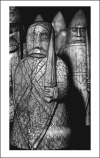 |
Scottish Annotated Games |
Last updated 21 March 2002


|
Muir, A - Peretjatkowicz, T [A67]
Tournament of Merited Teams, 1989
[Notes by Andy Muir]
1.d4
Nf6
2.c4
c5
3.d5
e6
4.Nc3
exd5
5.cxd5
d6
6.e4
g6
7.f4
Bg7
8.Bb5+
Nfd7
[Taimanov's Variation and this is the main line, stopping threats of e5. However, 8... Nbd7
is a provocative alternative played at the highest level, eg 8... Nbd7 9.e5 dxe5 10.fxe5 Nh5
11.e6 Qh4+ 12.g3 Nxg3 13.hxg3 Qxh1 14.Be3 Bxc3+ 15.bxc3 a6 16.exd7+ Bxd7 17.Bxd7 Kxd7 18.Qb3! and
White won in Sokolov-Topalov, 1996.]
9.a4
0-0
10.Nf3
a6
11.Be2
[It is a question of style where to retreat this bishop. On e2, it is intended to meet Black's
plan of ... Nf6 and ... Bb4 with e5. One of my recent adversaries, Adrian Hollis, was one of the first
to play in this way. 11.Bd3 is another option when White would play for f5 instead.]
11...Qc7
[Unusual. Now, not 12.Nd2? Bd4!]
12.0-0
c4!?
[Now we see the point of 11... Qc7. Black intends to develop his d7 knight on c5 and unravel
his development another way. He is prepared to sacrifice the c4 pawn if necessary.]
13.Nd2
b5!
[Not 13... Nb6? 14.a5. Black sacrifices his less useful b-pawn rather than the c-pawn which is
controlling some important squares.]
14.axb5
Nb6
15.Kh1!
[I want to be able to capture on b5 with my knight after ... axb5, without allowing Qc5+.
15.bxa6? is too greedy. Black can play Bxa6 followed by N8-d7-c5 with great dark-square control,
similar to that enjoyed in the Benko Gambit.]
15...Bd7!
[This improves on 15... N8d7 16.e5! dxe5 17.Nde4 Bb7 18.bxa6 Rxa6 19.Rxa6 Bxa6 20.f5! Bb7 21.f6
and White should win as in Li Zunian-Sax, 1985.]
16.e5!
[I decide to sacrifice a pawn now, meeting 16... dxe5 by 17.Nde4 rather than pawn-grabbing by
16.bxa6.]
16...axb5
17.Rxa8
Nxa8
18.exd6!?
[I could have played 18.Nde4 here. Black is better place than the Li Zunian-Sax game, having a
bishop on d7 rather than the knight, and so can meet this with 18... dxe5 19.f5 Bxf5 though 19.d6 is
possible. I decide to regain my material with a tempo attack on the black queen.]
18...Qxd6
19.Nde4
Qb4!
[The most active square for the queen.]
20.Qc2
[I have to waste a tempo defending my b-pawn. I didn't like 20.Be3 Qxb2 21.Bd4 b4! 22.Bxg7 Kxg7
23.Qd4+ f6 24.Rb1 Qa3 25.Qc5 Na6 when Black has a dangerous passed pawn, or 20.d6 (giving up the c6
square to the Nb8), eg 20... Nb6 21.Be3 Qxb2 22.Bd4 Nc6!]
20...Na6
21.Be3
[If 21.d6 Bf5!]
21...Re8
[Threatening 22... f5.]
22.Ra1!
Bc8?
[I didn't like this move at the time, but I can't remember why! I have given it a ? in my old
notes, but if 22... N6c7 23.Bc5 or 22... N8c7 23.d6 seem good for White, perhaps 23... Bc6
24.dxc7 Nxc7 25.Bf3 f5 might give some counterplay.]
23.d6!
Bb7
[If 23... f5 24.Nd5 Qxb2 25.Qxb2 Bxb2 26.Nef6+ Kf7 27.d7! Bxd7 28.Rxa6 saves the rook just
in time.]
24.Bf3
f5
[Forcing the Ne4 to choose a square. If 24... Kh8 25.d7 Rd8 26.Ng5 wins.]
25.d7
Rb8
26.Nf6+!
Bxf6
27.Bxb7
N6c7
[If 27... Rxb7 28.Rxa6 Qf8 (or if 27... N8c7 28.Bxa6) 29.Qd2 Rb8 30.Qd5+ Kg7 31.Rxf6+ Kxf6
32.Bd4+ wins.]
28.Qd2!!
[My favourite move of the game. A waiting move, controlling the important squares d4, d5 d7, d8. The more direct 28.Nd5? fails to 28... Nxd5 29.Bxd5+ Kg7 30.Bxa8 Rxa8 31.Rxa8 Rxa8 32.Bg1 Bd4 33.Rg8+ Kh6! and Black wins! Or 28.Bf3 Kg7! and ... Qf8 and Black defends more easily.]
28...Rxb7
[If 28... Qf8 29.Nd5, or 28... Kg7 29.Bxa8 Nxa8 30.Bd4 Qd6 31.Nxb5!]
29.Rxa8+!
1-0
[Since if 29... Nxa8 30.Qd5+ wins.]
| Click to return to index page Games Index |
Click to download in PGN format Muir v Peretjatkowicz |
Generated with ChessBase 8.0 |





















